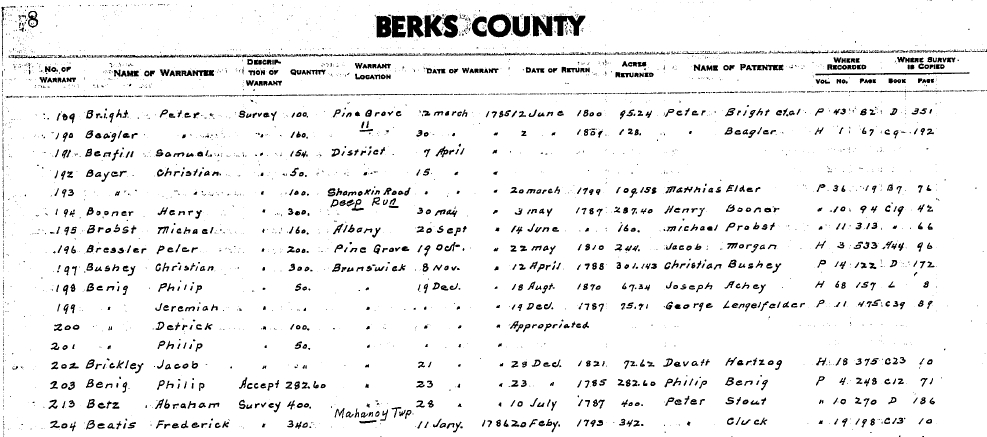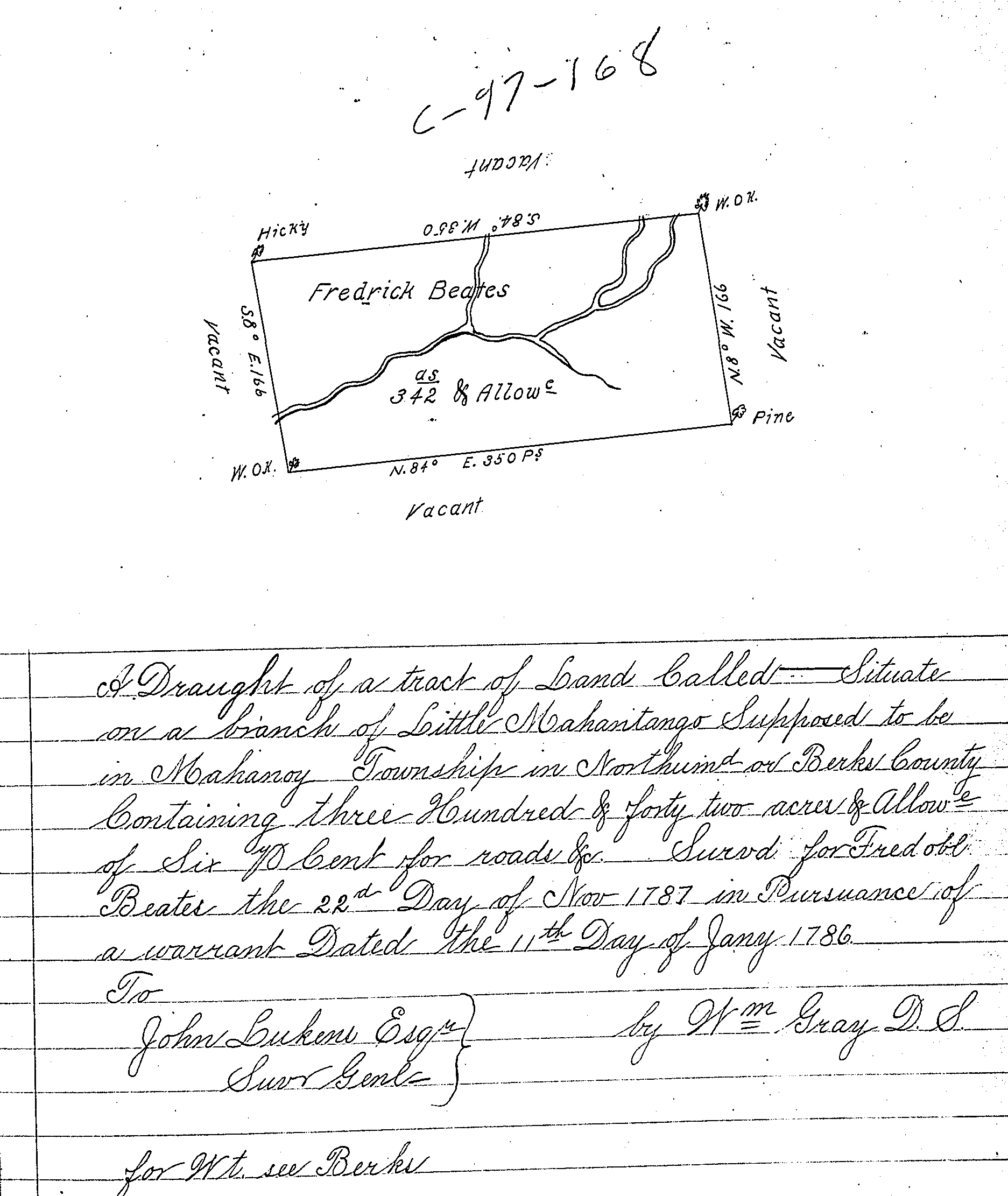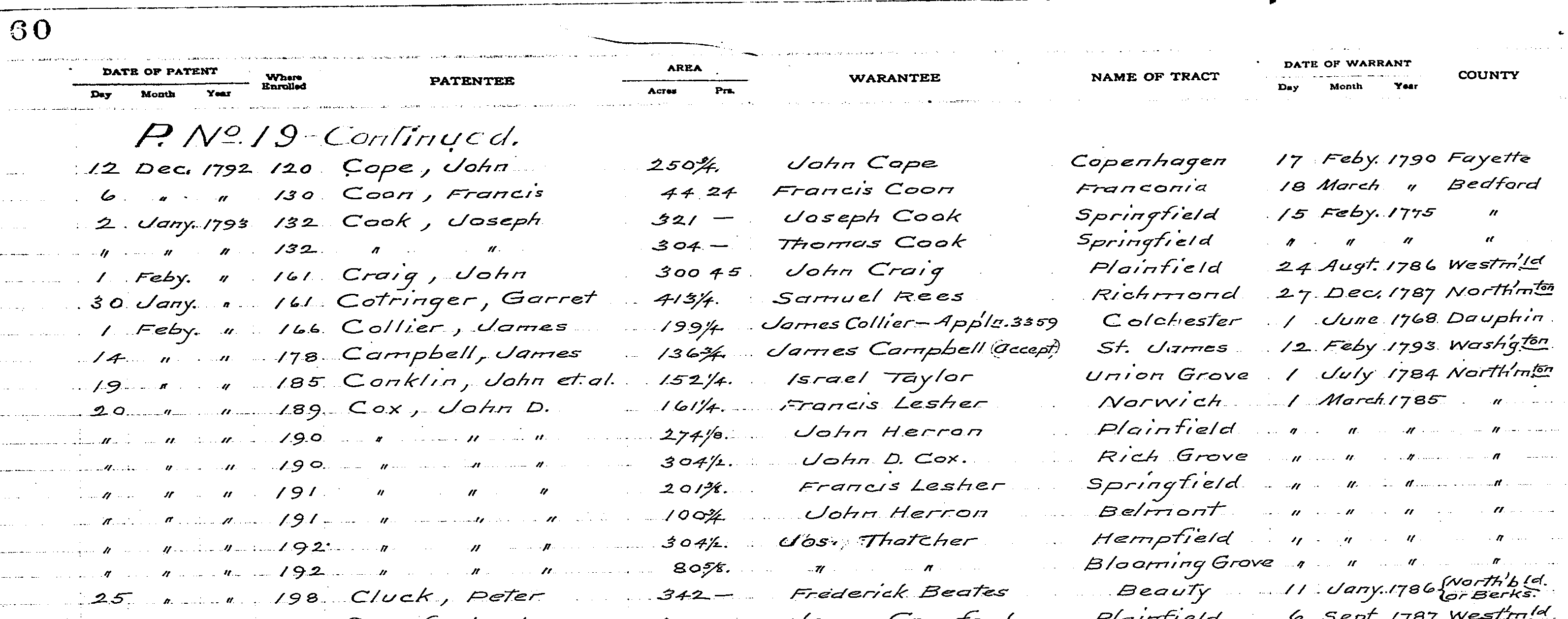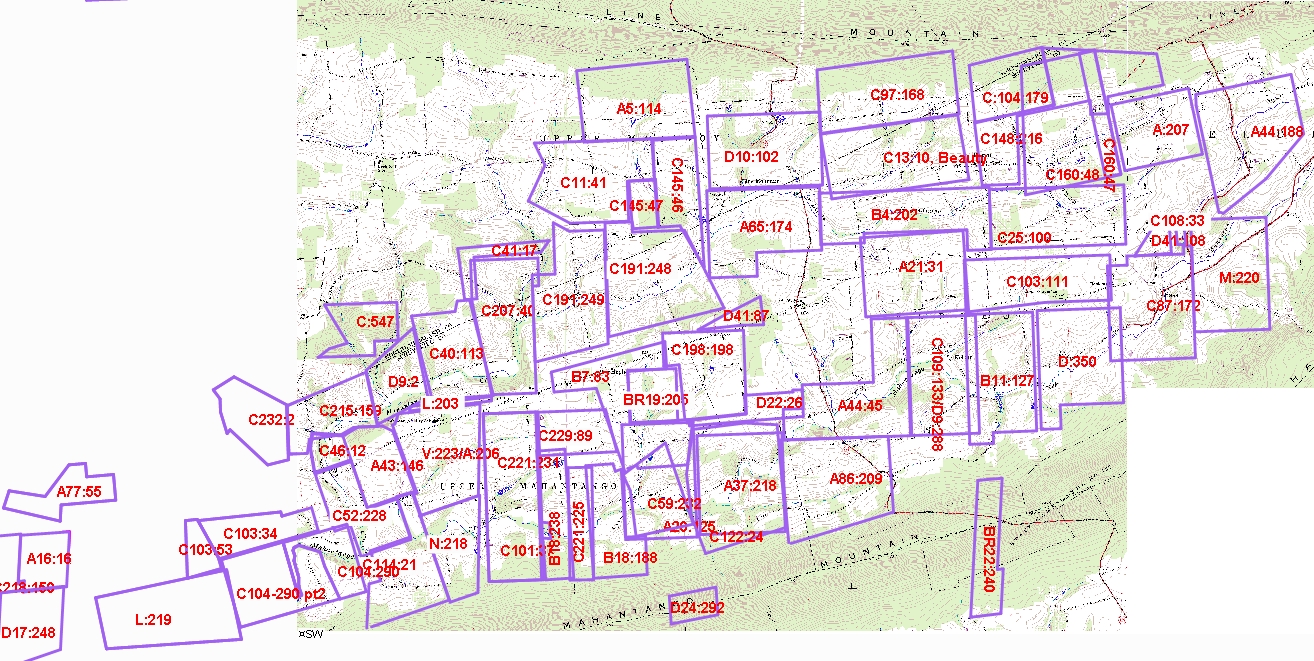New!
Pennsylvania Land Records
Following is enough information for you to get started with Pennsylvania land records . Much more could be said (but then you'd stop reading!), so let's just hit the basics. To get started, you need to understand the the four steps in acquiring land. If your ancestor was a recent arrival, you can skip the first three.
- Warrant
- Survey
- Patent
- County Deed
In the early days of Pennsylvania, the above system was developed in order to encourage settlement of the state as lands were acquired (usually be deeds between the state and the local Native Americans). There was a steady stream of new immigrants looking for new cheap farm land. In exchange for clearing and settling on the land, they could own their own farm. Unfortunately, there were a lot of land speculators who you will find involved in buying and selling the new land for a large profit, despite the spirit of the system designed to reward the new immigrants for their work.
The land warrant was a permission to acquire a stated amount of land at a designated area. Next, the land would be surveyed and the survey returned. Finally, the land would be patented and the new owner would have permanent ownership of the land. After this, land transactions would take place with the normal deeds at the county court level. As you will see, as simple as this sounds, quite often this process took several years, and the land actually changed hands multiple times before the patent was acquired. The ownership may have transferred among relatives or land speculators, neighbors, etc. Don't read too much into who purchased the land.
There were a number of special land offerings called the East Side and West Side Applications (and others), but we'll save that for another day.
Your ancestor could be listed as either the originator (warrantee) or the final owner (patentor) so you might want to check at both ends. Realize that most of these transcations are from the early 1700's to the earliest 1800's. Most of the land in the east was patented before 1800. Let's look where to search in the Pennsylvania Land Records, step-by-step. As you gain understanding of the system, be sure to check out all the links at the PA Archives site.
Pennsylvania Archives Warrant Index
The first step is to check the County Warrant Register. This will require you to select one county and then open several pages for the index. I recommend right clicking in your browser to open each one in a new tab to prevent all the back-and-forth web page loading. When you find a match, write down all of the information. In particular, you'll want the survey number and patent book number (see more notes on this web page). You might also want to check out the easier-to-use single file Warrant Registers on CD-ROM from Ancestor Tracks.
Ancestry.com has some additional information that can help with warrants:
The first collection above has images of original warrant applications which in some cases shows the actual application list approximate location, neighbors, etc, which can go beyond what you'll find in PA Archives warrant register. To get additional information, you'll need to use the warrantee's name and the county where the application was made (not the current county!) and look up the name to get the survey number.
The second collection above is a text-only listing of warrantee names. In both collections, this may make searching for warrants faster than scanning through the PA Archives.
In the following example, you'll see that Frederick Beates (aka Beatis) took out the warrant in Berks County in 1786. It says Mahanoy Twp, but the land was really in Mahantongo Twp, and the land later became modern-day Schuylkill County. The warrantee was my ancestor Peter Klock (although spelled "Cluck" here). The survey is listed on the right as C13:10 (these are free online)

Pennsylvania Archives Copied Surveys
Armed with a survey number, you can then check the Copied Survey Collection which has drawings of the land boundaries, location, acreage, neighbors and perhaps some record of land transcations. Note that these are "copied" surveys. The original surveys may also exist (there are are some for Northampton County with the estate records on ancestry.com.
The following example survey corresponds with the entry above (available free online). It shows an approximate location of the Little Mahantongo Creek, which is an aid to identifying the location on map.

Pennsylvania Archives Land Patent Index
Finally, you can search for additional information in the Patent Index. Note that if you found a warrant in the step above, you need to check the column for who completed the patent application and search for that name in the patent index (not the warrantee's name). There is not much useful information in the patent index except the tracts name, if it had one (which may appear later in some deeds). You might also want to check out the single file Patent Indices from Ancestor Tracks, which are easier to use.
The following example shows the entry in the Pennsylvania Patent index (free online) showing the name of the tract as "Beauty".

Pennsylvania County Deeds
After this, you will need to check county deeds for land transactions. Realize that not all transactions, especially in the earliest days, ended up being recorded in the county court house. A subsequent land transaction may make reference to earlier unrecorded transactions.
Following are some county records available online. For some you may need to create a free account. Then you may be able to see but not save the deed image (a screen shot may be able to save the information you need for genealogical research.
- Master Index of propertyinfo.com
- Berks County Deeds (free to search and view, pay to download)
- Lancaster County Deeds (free to search and view)
The following shows a snippet from the introduction of a deed referencing the above tract from Peter Klock called "Beauty" on the Little Mahantongo Creek. It also references Patent Book No 19, page 198. So if you started with the deed, you could work backwards, deed → patent → warrant → survey.

Deed Mapping Projects
To plot and combine plots, I highly recommend Deed Mapper. I shopped around and tried another product, but found this to be tailored to genealogical research. You can overlay the boundaries on map images and even export them to Google Earth.
In addition to sofware, if you are going to do any big projects in Pennsylvania, like creating a township connected survey map, I'd recommend these things:
- Download and combine the PA Archive Patent indices PDF pages into a single big PDF (DownThemAll! on Firefox + PDFSam, both free)
- Download and combine the PA County Warrent indices PDF pages into a single big PDF (DownThemAll! on Firefox + PDFSam, both free)
- Download the PDF survey images in your area to your PC and rip them into image files (I batch use pdfimages on Linux PC)
Having those files on a local PC eliminates all the back-and-forth of opening PDF files on the web.
 Mahantongo Valley, Schuylkill County, PA Land Ownership Project
Mahantongo Valley, Schuylkill County, PA Land Ownership Project
See the details of my first deed project by clicking here!

Deed and Estate Docket Index Decoders
You will find several different index methods used for deeds and estate records which seem to be based on using all the paper (by grouping less used letter combinations together) or finding phoenetically similar names next to each other, or just to confuse the non-deed-savy public. Regardless of motives, I'll post some decoders below as I get time.
Links
Helpful links
- Deed Mapper software (you need to pay for this, but it's worth it!
- Libre Map (free cartographic maps)
- Ancestor Tracks (historic maps in PA by county)
- More historic PA maps
- PA Aerial Photos from the 1930's onward (very useful for background images)
- Pennsylvania Land Records #1
- Pennsylvania Land Records #2
Current GIS (just google for your county name and GIS for current boundary maps)
- Lehigh County current parcel map
- Northumberland County current parcel map
- Schuylkill County current parcel map
- Union County current parcel map
- Snyder County current parcel map
Old Deeds
- PA Warrant Applications (LDS)
- PA New Purchase Applications (LDS)
- Old PA Deeds and misc records (mainly Northampton area) (LDS)
- PA Berks Deeds (LDS)
- PA Berks Misc Deeds (LDS)
- PA Bucks Deeds (LDS)
- PA Bucks Misc Records (LDS)
- PA Fayette Deeds (LDS)
- PA Lehigh Deeds (LDS)
- PA Northampton Deeds (LDS)
- PA Northampton Warrants
- PA Schuylkill Deeds (LDS)
- New York Land Records at Family Search (LDS)
Temporary Links Here (will move to separate pages later)
Berks County, PA Deed Grantor Index
- A surname
- B surname
- B surname (contd)
- C surname
- D surname
- E surname
- F surname
- G surname
- G surname (contd)
- H surname
- H surname (contd)
- I/J surname
- K surname
- K surname (contd)
- L surname
- M surname
- M surname (contd)
- N/O surname
- P/Q surname
- R surname
- R surname (contd)
- S surname
- S surname (contd)
- T/U/V surname
- W surname
- X/Y/Z surname
Berks County, PA Deed Grantee Index
- A surname
- B surname
- B surname (contd)
- C surname
- D surname
- E surname
- F surname
- G surname
- G surname (contd)
- H surname
- I/J surname
- K surname
- L surname
- M surname
- N/O surname
- P/Q surname
- R surname
- R surname (contd)
- S surname
- S surname (contd)
- T/U/V surname
- W surname
- X/Y/Z surname
Berks County, PA Deed Books
- A1 deed book
- B1 deed book
- A2 deed book
- B2 deed book
- A3 deed book
- B3 deed book
- 4 deed book
- 5 deed book
- 6 deed book
- 7 deed book
- 8 deed book
- 9 deed book
- 10 deed book
- 11 deed book
- 12 deed book
- 13 deed book
- 14 deed book
- 15 deed book
- 16 deed book
- 17 deed book
- 18 deed book
- 19 deed book
- 20 deed book
- 21 deed book
- 22 deed book
- 23 deed book
- 24 deed book
- 25 deed book
- 26 deed book
- 27 deed book
- 28 deed book
- 29 deed book
- 30 deed book
- 31 deed book
- 32 deed book
Northumberland County, PA Deed Grantor Index
- A surname
- Ba surname
- Bi surname
- C surname
- D surname
- E surname
- F surname
- G surname
- H surname
- I surname
- J surname
- K surname
- L surname
- Mc surname
- M surname
- N surname
- O surname
- P surname
- Q surname
- R surname
- Sa surname
- Sm surname
- T surname
- U surname
- V surname
- W surname
- Y surname
- Z surname
Northumberland County, PA Deed Grantee Index
- A surname
- Ba surname
- Bi surname
- C surname
- D surname
- E surname
- F surname
- G surname
- H surname
- I surname
- J surname
- K surname
- L surname
- Mc surname
- M surname
- N surname
- O surname
- P surname
- Q surname
- R surname
- Sa surname
- Sm surname
- T surname
- U surname
- V surname
- W surname
- Y surname
- Z surname
Northumberland County, PA Deed Books
- A deed book
- B deed book
- C deed book ?
- D deed book ?
- E deed book
- F deed book
- G deed book
- H deed book
- I deed book
- K deed book
- L deed book
- M deed book
- N deed book
- O deed book
- P deed book
- Q deed book
- R deed book
- S deed book
- T deed book
- U deed book
- V deed book
- W deed book
- X deed book
- Y deed book
- Z deed book
- AA deed book
- BB deed book
- CC deed book
- DD deed book
- EE deed book
- FF deed book
- GG deed book
- HH deed book
- JJ deed book
- KK deed book
- LL deed book
- MM deed book
- NN deed book
- OO deed book
- PP deed book
- QQ deed book
- RR deed book
- SS deed book
- TT deed book
- UU deed book
- VV deed book
- WW deed book
- XX deed book
Schuylkill County, PA Deed Grantor Index (surname letter, then first name, then consonant in surname!)
- A surname
- B surname
- C surname
- D surname
- D surname (contd)
- E surname
- F surname
- G surname
- H surname
- H surname (contd)
- I/J surname
- K surname
- L surname
- M surname
- M surname (contd)
- N/O surname
- P/Q surname
- R surname
- S surname
- T surname
- U/V surname
- W surname
- W surname (contd)
- Y/Z surname
Schuylkill County, PA Deed Grantee Index
- A surname
- Ba-Bl surname
- Bo-Bz surname
- C surname
- D surname
- E surname
- F surname
- G surname
- H surname
- I surname
- J surname
- K surname
- L surname
- M surname
- N surname
- N/O surname (contd)
- O surname
- P surname
- Q surname
- R surname
- Sa-Sk surname
- Sl-Sz surname
- T surname
- U surname
- V surname
- W surname
- Y surname
- Z surname
Schuylkill County, PA Deed Books
- 1 deed book
- 2 deed book
- 2 deed book (contd)
- 3 deed book
- 4 deed book
- 5 deed book
- 5 deed book (contd)
- 6 deed book
- 7 deed book
- 7 deed book (contd)
- 8 deed book
- 9 deed book
- 9 deed book (contd)
- 10 deed book
- 11 deed book
- 11 deed book (contd)
- 12 deed book
- 13 deed book
- 13 deed book (contd)
- 14 deed book
- 15 deed book
- 15 deed book (contd)
- 16 deed book
- 17 deed book
- 17 deed book (contd)
- 18 deed book
- 19 deed book
- 20 deed book
- 20 deed book (contd)
- 21 deed book
- 22 deed book
- 23 deed book
- 24 deed book
- 25 deed book
- 26 deed book
- 26 deed book (contd)
- 27 deed book
- 28 deed book
- 29 deed book
- 29 deed book (contd)
- 30 deed book
- 31 deed book
- 31 deed book (contd)
- 32 deed book
- 33 deed book
- 33 deed book (contd)
- 34 deed book
- 35 deed book
- 36 deed book
- 36 deed book (contd)
- 37 deed book
- 38 deed book
- 38 deed book (contd)
- 39 deed book
- 40 deed book
- 40 deed book (contd)
- 41 deed book
- 41 deed book (contd)
- 42 deed book
- 43 deed book
- 43 deed book (contd)
- 44 deed book
- 45 deed book
- 45 deed book (contd)
- 46 deed book
- 47 deed book
- 47 deed book (contd)
- 48 deed book
- 49 deed book
- 49 deed book (contd)
- 50 deed book
- 51 deed book
- other thorugh vol 281
Crawford County, PA Deed Index-Conrad
Crawford County, PA Deed Index-Stainbrook
Books
Links
Here are some books that I have found to be useful to use in addition to the links above:
| Pennsylvania Land Records (good for understanding the land process) |
Patreon
Do you find these pages helpful? (these projects require subscriptions, books, CD's, to get done). If so, consider visiting my Patreon page and make a small donation.
